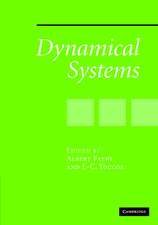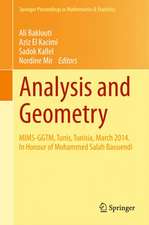Introduction to Numerical Methods for Variational Problems: Texts in Computational Science and Engineering, cartea 21
Autor Hans Petter Langtangen, Kent-Andre Mardalen Limba Engleză Paperback – 15 oct 2020
| Toate formatele și edițiile | Preț | Express |
|---|---|---|
| Paperback (1) | 394.87 lei 6-8 săpt. | |
| Springer International Publishing – 15 oct 2020 | 394.87 lei 6-8 săpt. | |
| Hardback (1) | 511.37 lei 6-8 săpt. | |
| Springer International Publishing – 15 oct 2019 | 511.37 lei 6-8 săpt. |
Din seria Texts in Computational Science and Engineering
- 15%
 Preț: 595.86 lei
Preț: 595.86 lei -
 Preț: 400.26 lei
Preț: 400.26 lei - 19%
 Preț: 544.68 lei
Preț: 544.68 lei - 4%
 Preț: 466.32 lei
Preț: 466.32 lei - 20%
 Preț: 325.00 lei
Preț: 325.00 lei - 20%
 Preț: 588.53 lei
Preț: 588.53 lei -
 Preț: 389.11 lei
Preț: 389.11 lei -
 Preț: 416.01 lei
Preț: 416.01 lei -
 Preț: 430.21 lei
Preț: 430.21 lei -
 Preț: 439.07 lei
Preț: 439.07 lei -
 Preț: 451.55 lei
Preț: 451.55 lei -
 Preț: 494.11 lei
Preț: 494.11 lei - 15%
 Preț: 608.08 lei
Preț: 608.08 lei -
 Preț: 393.90 lei
Preț: 393.90 lei -
 Preț: 387.75 lei
Preț: 387.75 lei -
 Preț: 504.50 lei
Preț: 504.50 lei -
 Preț: 396.62 lei
Preț: 396.62 lei -
 Preț: 482.45 lei
Preț: 482.45 lei - 20%
 Preț: 338.03 lei
Preț: 338.03 lei -
 Preț: 498.91 lei
Preț: 498.91 lei -
 Preț: 398.35 lei
Preț: 398.35 lei -
 Preț: 390.84 lei
Preț: 390.84 lei
Preț: 394.87 lei
Nou
Puncte Express: 592
Preț estimativ în valută:
75.56€ • 79.15$ • 62.62£
75.56€ • 79.15$ • 62.62£
Carte tipărită la comandă
Livrare economică 09-23 aprilie
Preluare comenzi: 021 569.72.76
Specificații
ISBN-13: 9783030237905
ISBN-10: 3030237907
Pagini: 395
Ilustrații: XVI, 395 p. 88 illus., 76 illus. in color.
Dimensiuni: 155 x 235 mm
Greutate: 0.58 kg
Ediția:1st ed. 2019
Editura: Springer International Publishing
Colecția Springer
Seria Texts in Computational Science and Engineering
Locul publicării:Cham, Switzerland
ISBN-10: 3030237907
Pagini: 395
Ilustrații: XVI, 395 p. 88 illus., 76 illus. in color.
Dimensiuni: 155 x 235 mm
Greutate: 0.58 kg
Ediția:1st ed. 2019
Editura: Springer International Publishing
Colecția Springer
Seria Texts in Computational Science and Engineering
Locul publicării:Cham, Switzerland
Cuprins
Preface.- Quick overview of the finite element method.- Function approximation by global functions.- Function approximation by finite elements.- Variational formulations with global elements.- Variational formulations with finite elements.- Time-dependent variational forms.- Variational forms for systems of PDEs.- Nonlinear Problems.- Variational forms for linear systems.- Useful formulas.
Recenzii
“Hans Petter Langtangen's spirit and passion for computational science, education, and interdisciplinary collaboration continues to manifest through a text that is lively, conversational, informative, approachable, and interactive.” (Akil Narayan, SIAM Review, Vol. 62 (4), 2020)
“Introduction to Numerical Methods for Variational Problems is well-suited for undergraduate or beginning graduate students in applied mathematics, physics, or engineering that want to begin to learn about the numerical analysis of or scientific computing with PDEs. … Introduction to Numerical Methods for Variational Problems seems to me like a very good place to start.” (MAA Reviews, March 5, 2020)
“Introduction to Numerical Methods for Variational Problems is well-suited for undergraduate or beginning graduate students in applied mathematics, physics, or engineering that want to begin to learn about the numerical analysis of or scientific computing with PDEs. … Introduction to Numerical Methods for Variational Problems seems to me like a very good place to start.” (MAA Reviews, March 5, 2020)
Notă biografică
Hans Petter Langtangen (1962 - 2016) was a professor of computer science at the University of Oslo. He was formerly a professor of mechanics and was the Director of "Center for Biomedical Computing", a Norwegian Center of Excellence at the Simula Research Laboratory in Oslo. Langtangen has more than 100 scientific publications, including journal papers and many books, e.g., the bestseller TCSE 6 "A Primer on Scientific Programming with Python" (editions 1 - 5). He has also developed open source and commercial software systems for computational sciences.”
Kent-Andre Mardal is a professor of mechanics at the University of Oslo and an adjunct research scientist at Simula Research Laboratory. He has published more than 80 scientific publications, including journal papers, one co-authored book and the co-edited the book about the FEniCS project, for which he was a core developer for many years.
Textul de pe ultima copertă
This textbook teaches finite element methods from a computational point of view. It focuses on how to develop flexible computer programs with Python, a programming language in which a combination of symbolic and numerical tools is used to achieve an explicit and practical derivation of finite element algorithms. The finite element library FEniCS is used throughout the book, but the content is provided in sufficient detail to ensure that students with less mathematical background or mixed programming-language experience will equally benefit. All program examples are available on the Internet.
Caracteristici
Teaching the concept of finite elements or variational methods in general to students with less mathematical background Taking an explicit and practical approach and explaining the algorithmic aspects in detail Suitable already in the third year























